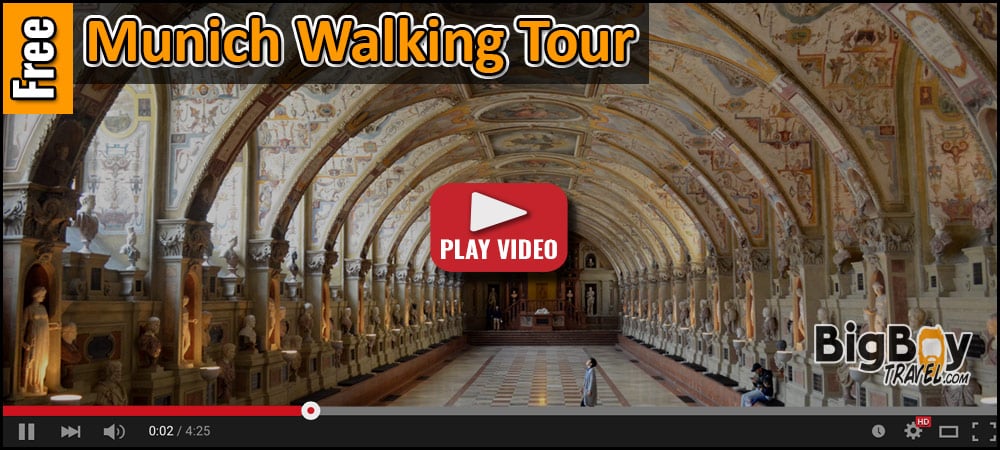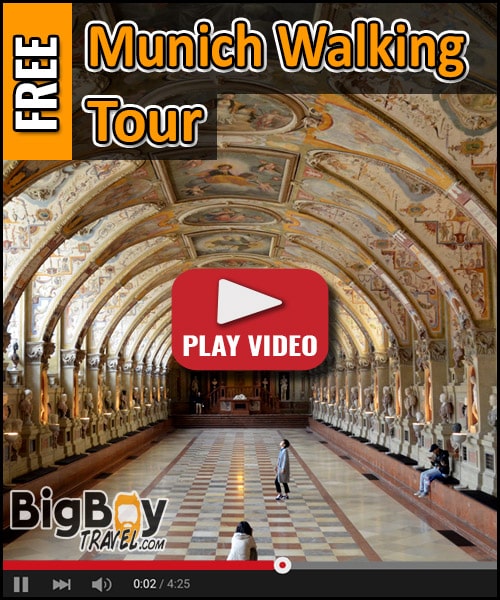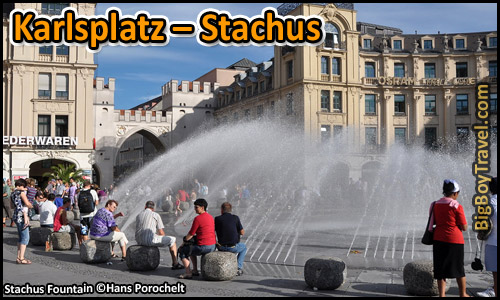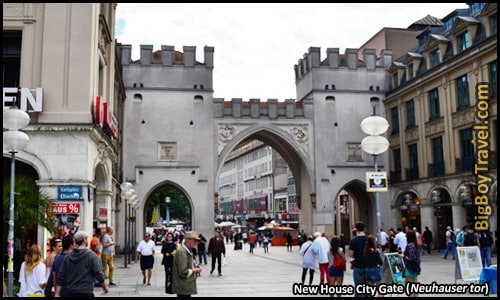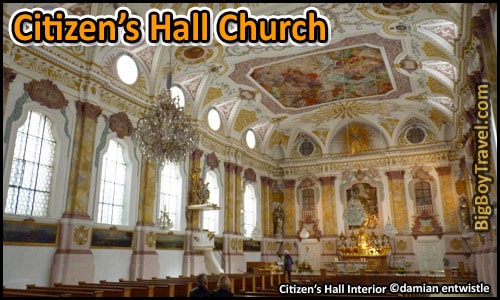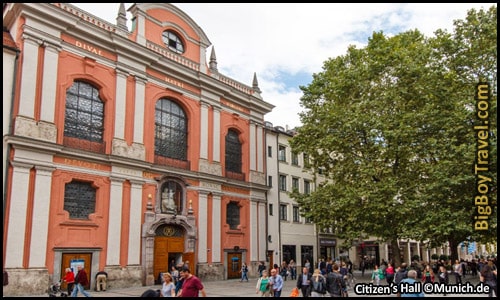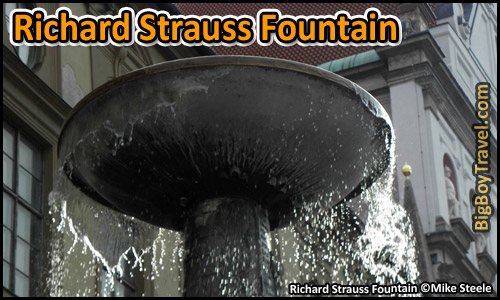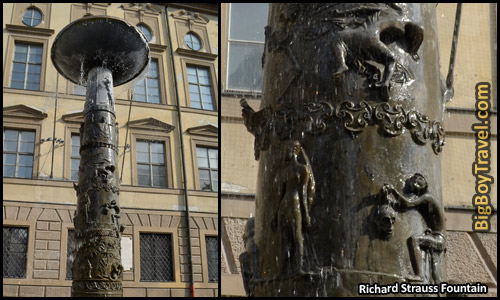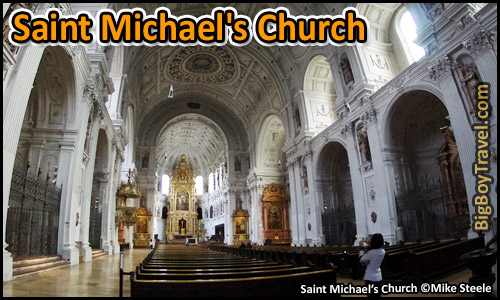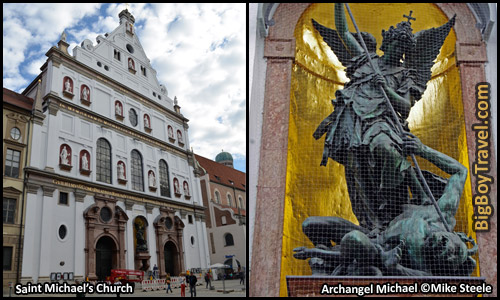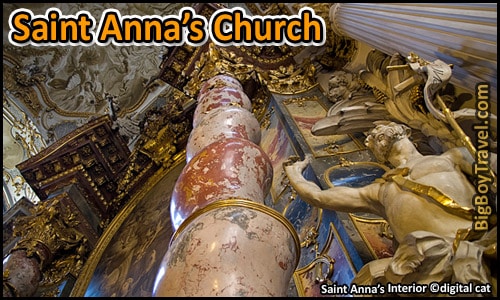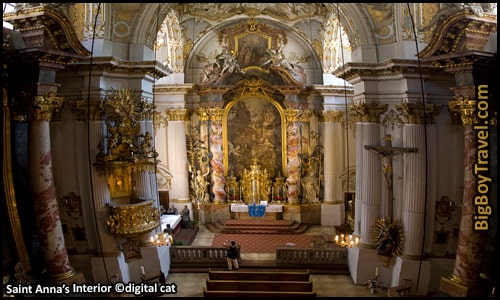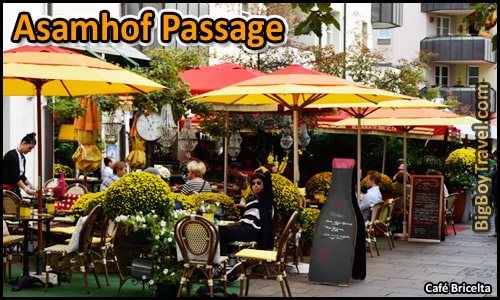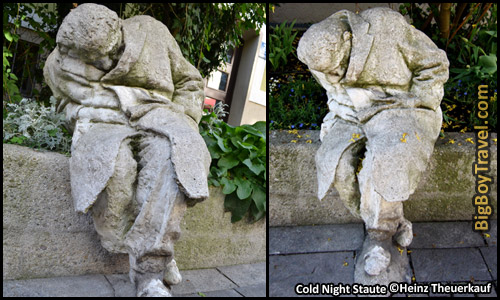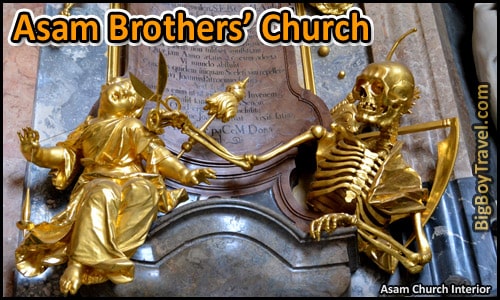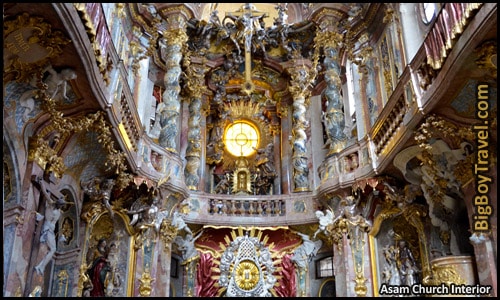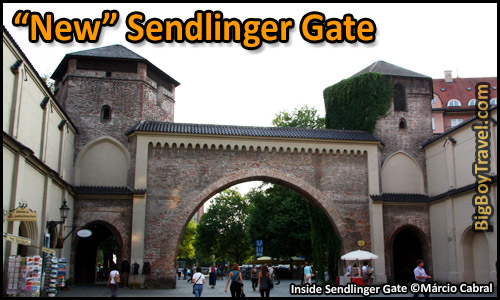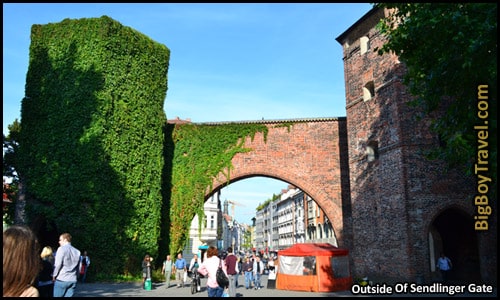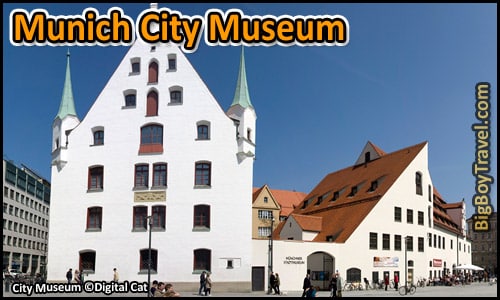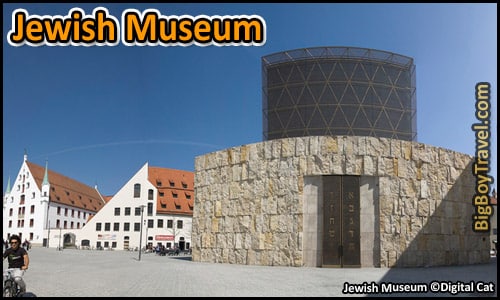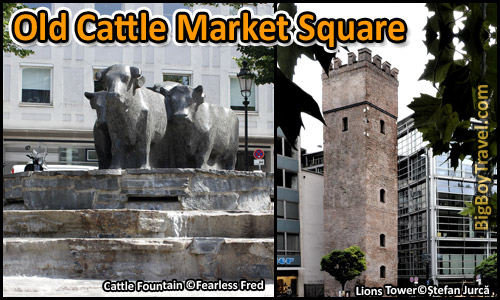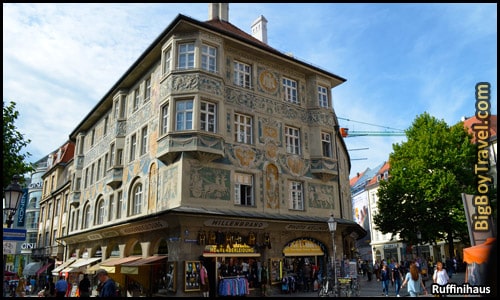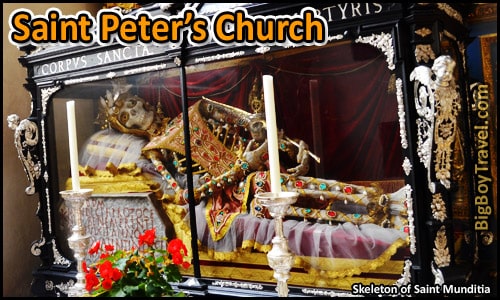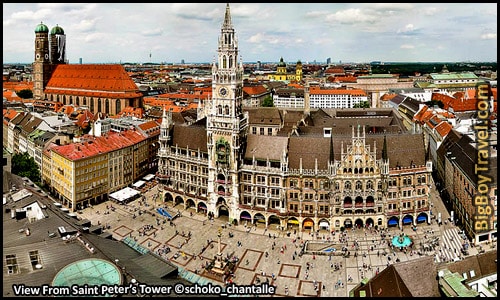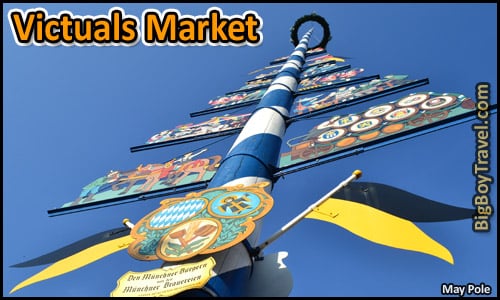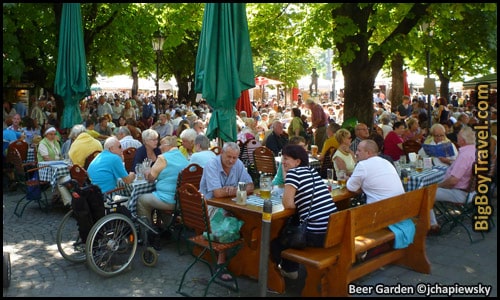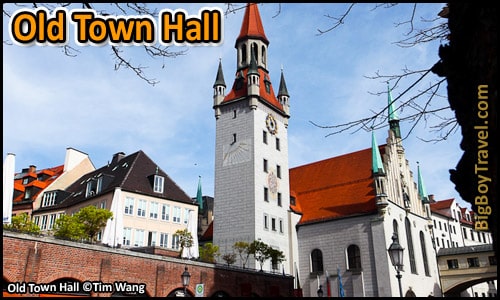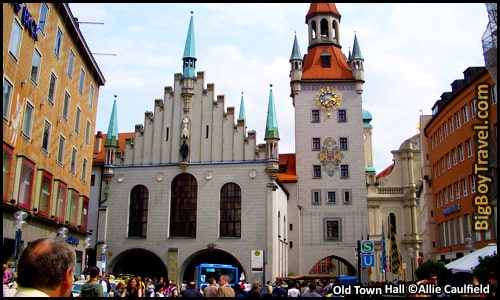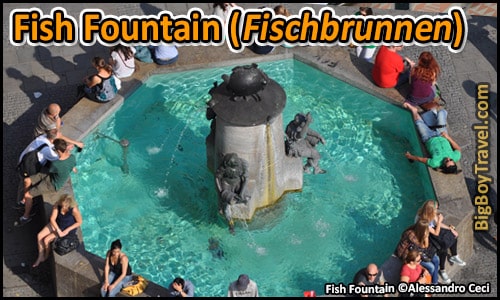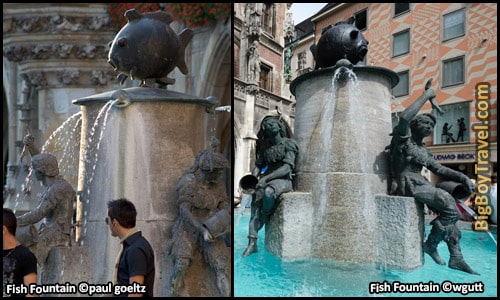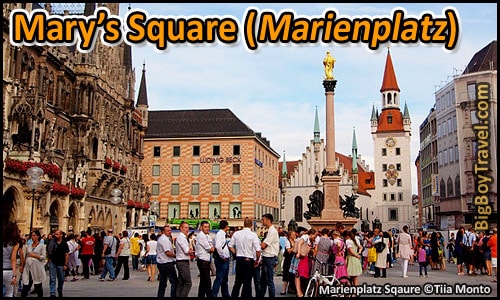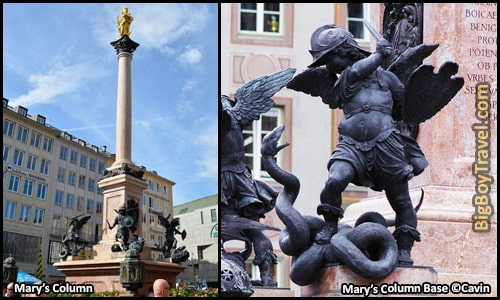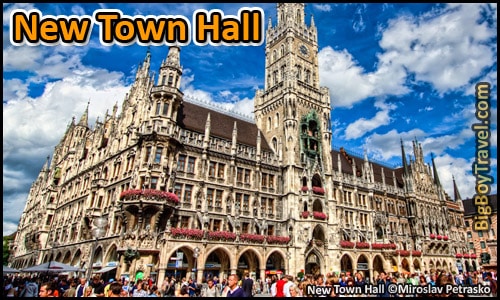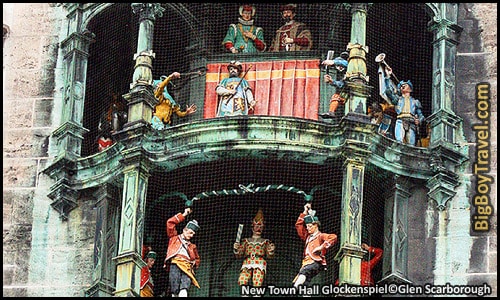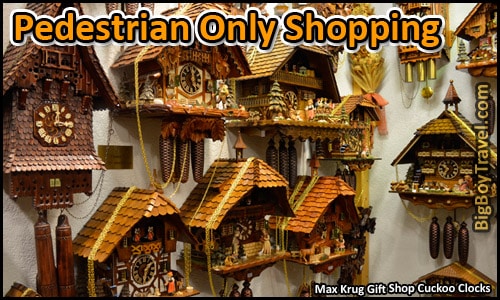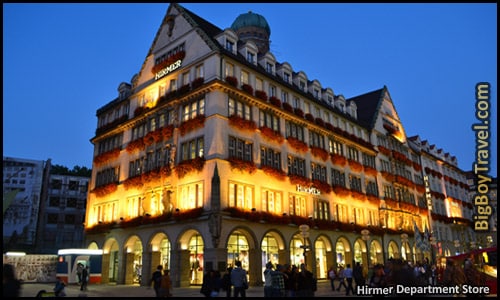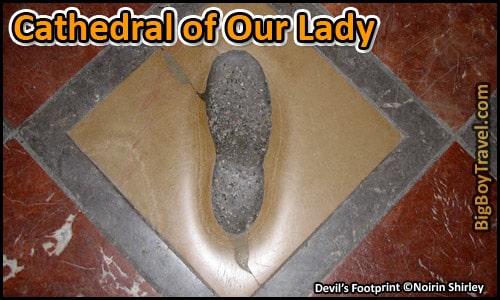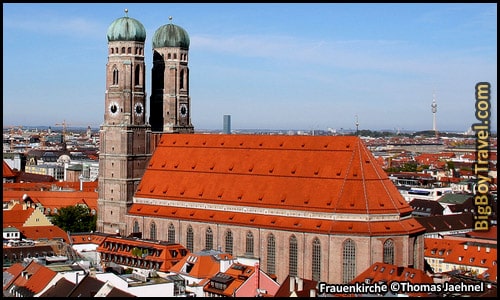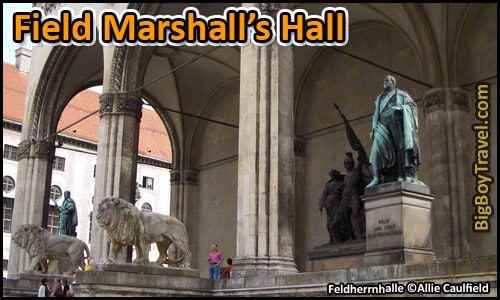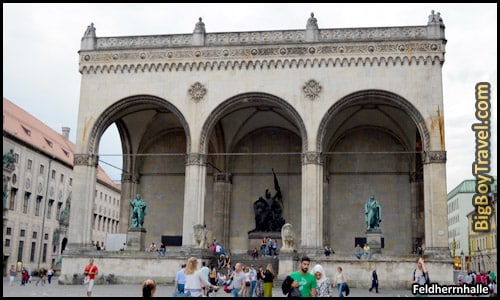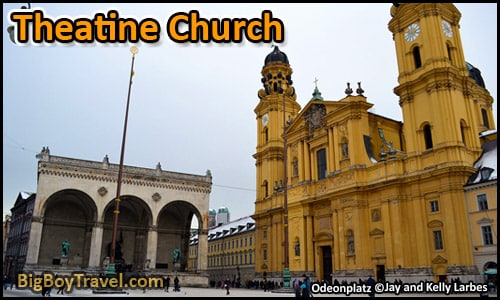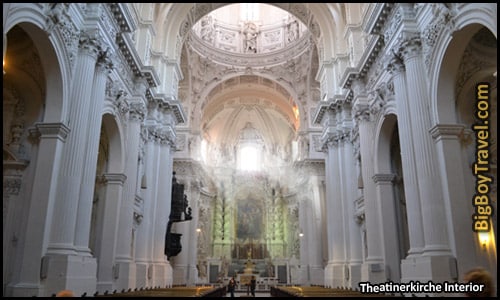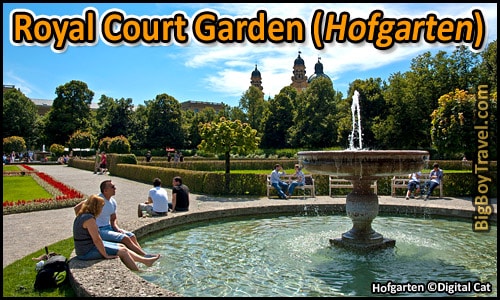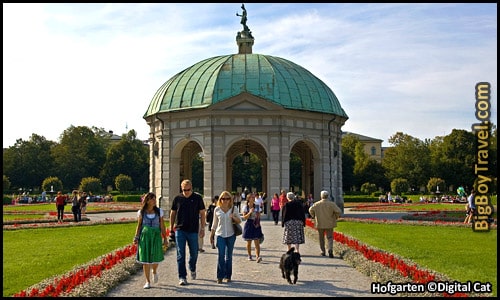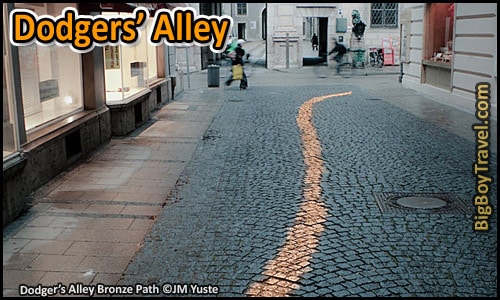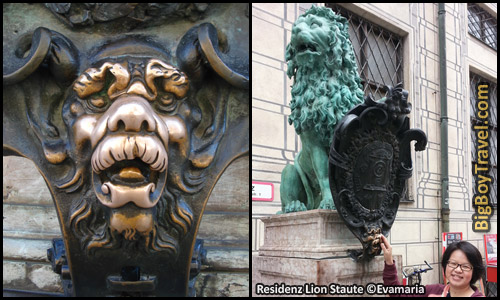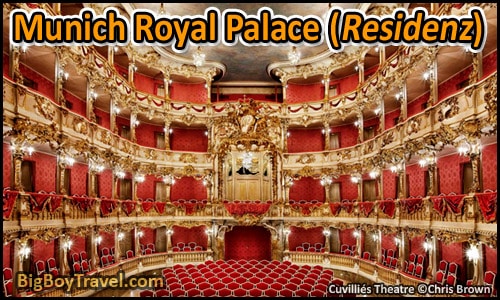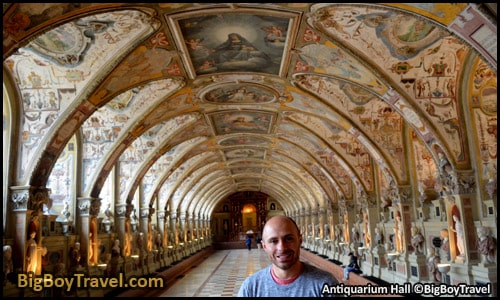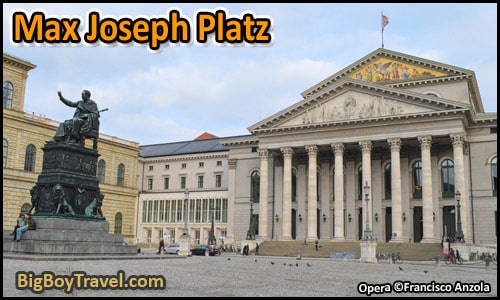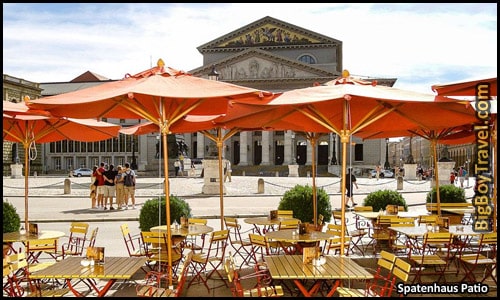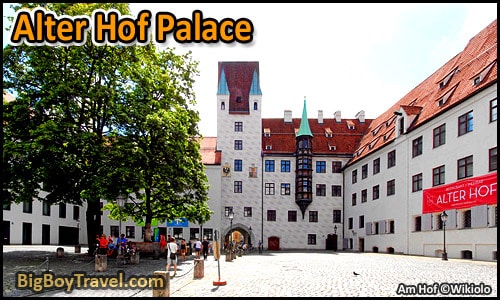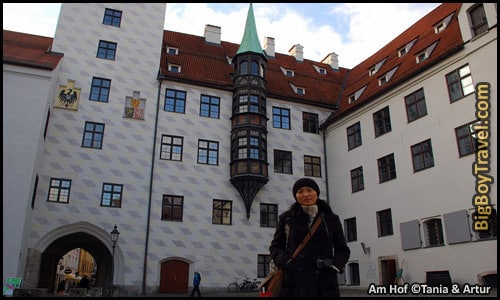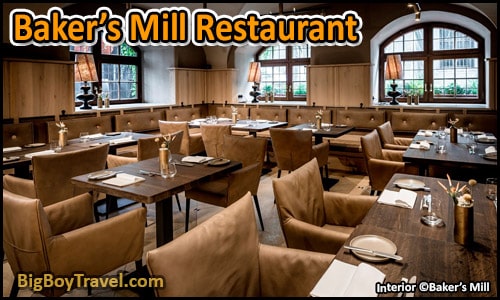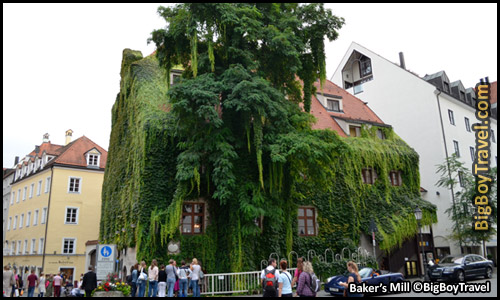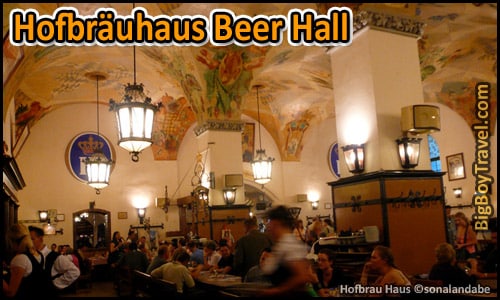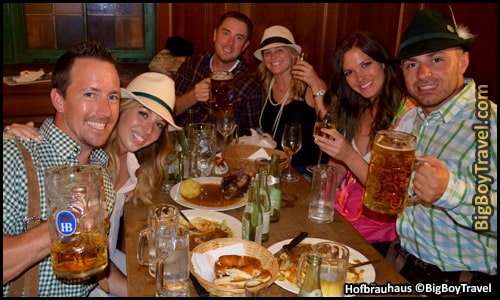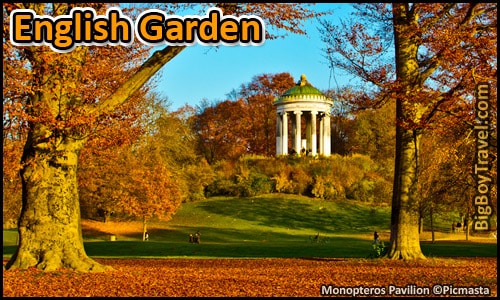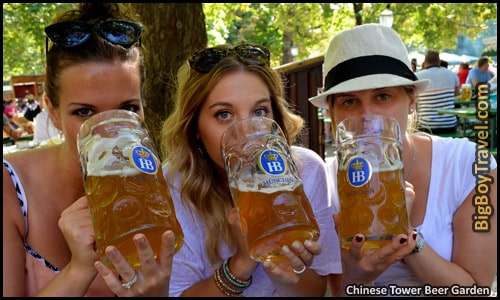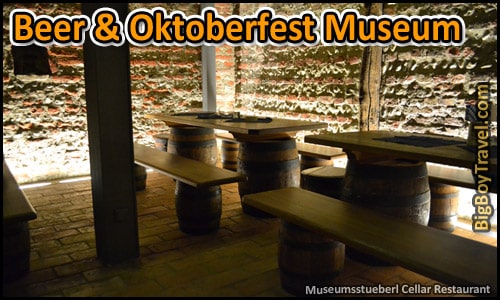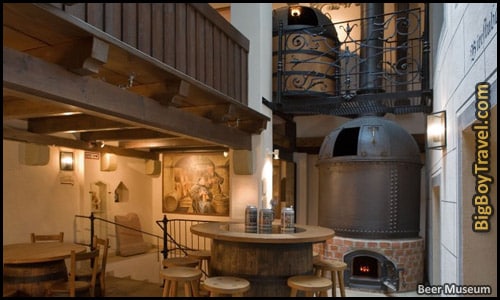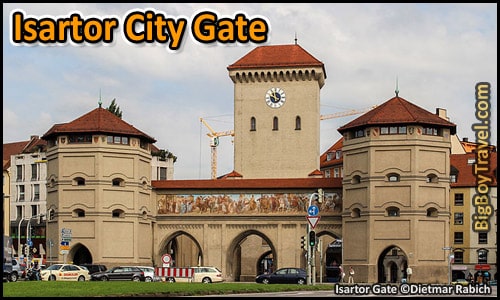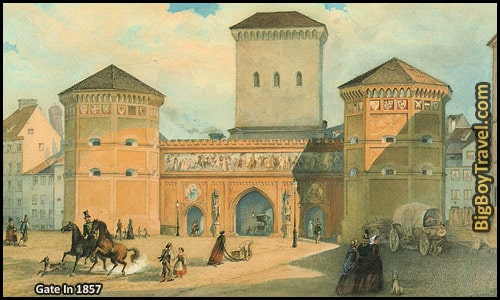Free Munich Walking Tour:
Walking Tour Location: Old Town Munich (Altstadt)
Cost: Free, Self-Guided (Museum and sight costs below)
Style: Do-It-Yourself Walking Tour (Self Guided)
Start: Karlsplatz Stachus Square & Metro Stop
End: Hofbräuhaus Beer Hall & Restaurant
Walking Distance: 2.5 miles
Time: 90 Minutes for Walk (Full tour 6+ hours with all stops)
Fun Scale: 9.5 out of 10
Munich’s compact Old Town is one of our favorite places to walk in Europe. Primarily geared toward pedestrians, the neighborhood truly is where old meets new and is a perfect setting for a free walking tour. Originally surrounded by a series of Medieval walls, you still enter Old Town Munich through the mighty city gates. Once inside you’ll experience great shopping mixed in with historic beers halls, amazing museums, and even a royal palace. The Bavarian atmosphere is very predominate everywhere you turn which adds to the fun of our free Munich walking tour.
To help you maximize your time in this wonderful city we have put together the perfect self-guided walking tour of Old Town for you. We go to Munich often, and this walking tour will make sure you hit up all the must-see attractions along with a couple of hidden gems. Enjoy our free Munich walking tour map!
Historical Overview of Old Town:
Settled by Benedictine Monks in the 700s, Old Town Munich is full of rich history. While Munich (München) means “by the monks”, you’ll see a lot of Lion Statues on this Old Town Munich walking tour because it was officially founded in 1158 by Henry the Lion. Early-day Munich was less than 1 square mile centered on Market Square and was surrounded by a gated Medieval wall.
As a growing trading power, Old Town Munich tripled in size by the 1300s and was surrounded by a larger wall with a wide moat to protect the booming city. The expansion of Old Town was largely fueled by Munich’s Wittelsbach family who took over ruling Bavaria in 1180 and quickly moved the capital from Regensburg to Munich. The powerful family formed an imperial dynasty through the year 1918 and even produced multiple Holy Roman Emperors along the way. Old Town Munich quickly became known around Europe for its museums, its beauty, and of course its festive beer halls.
Dark days came upon Munich after Hitler helped form the Nazi Party here starting in 1919 which eventually led to Old Town being heavily bombed in World War 2. Luckily as the new modern Munich rose out of the ashes, many of the historic sights were persevered or rebuilt. Today, Old Town Munich has a ton of great attractions and an unbeatable atmosphere to keep you coming back again and again. The sights on this free Munich walking tour will help you experience true Bavarian charm as you fall in love with Munich.
1. Karl’s Square – Stachus (Karlsplatz):
About Karlsplatz: We love to start our free Munich walking tour by entering one of Old Town’s city wall gates which date back to Medieval times. Our favorite gate is the castle-like New House Gate (Neuhausertor) on the Westside of Old Town near Karlsplatz Square. This lively square has been the primary Western entrance into Munich’s Old Town since the original Inner City Wall (Innere Stadtmauer, built 1156-75) was expanded into the Outer City Wall (Äußere Stadtmauer, built 1285-1347) to fit a rapidly growing city.
First built as a single tower gate called New House Tower (Neuhauser turm) in 1302, this was one of 4 main gates making up Munich’s new outer boundary. The entrance you see today was added right in front of the of the tall tower in 1337 as part of a new double-walled ditch which opened up to a wide protective moat that surrounded the entire city of Munich. The only way to access the New House Gate was over an impressive drawbridge that spanned the length of the current Karlsplatz Square until a stone bridge replaced it after the 30 Years War in the 1600s (See Photo). Following this post-war expansion, there were a total of 8 main gateways into the City Wall and almost 60 watchtowers scattered throughout Old Town Munich.
Most of the Western section of the city wall was later removed by Elector Karl Theodor in 1791 to make way for an expanding and modern city. With the wall section removed and the moat filled in, Karl gave the newly formed square and old New House Gate a facelift which both came to bear his name (Karlstor & Karlsplatz) after his death in 1799.
While Karl (reign 1777-99) did leave a positive mark on Munich by turning the royal hunting grounds as the English Garden park and expanding salt mining in Bad Reichenhall, he was widely unliked as a Wittelsbach-cousin outsider imported from the Netherlands. One of his missteps was ending the beloved Scarlet Horse Race (Scharlachrennen) in 1786 which had been held outside the city walls near today’s Karlsplatz since 1448. Karl also ended other local celebrations like the annual Butcher’s Leap which didn’t help his popularity with the commoners.
Because locals thought of Karl as an unfair ruler, they started calling the square by its nickname Stachus Square instead, after the Beim Stachus Pub that once stood near the New House Gate. Notice how we prefer to call the gate by its original name of New House instead of Karlstor. The tall central watch tower just inside the New House Gate was turned into gunpowder storage in the 1800s and remained standing until an explosion blew it up in 1857.
After devastating WW2 bombings, Karlsplatz Square required a ton of renovations, but has since turned into one of Old Town Munich’s focal points. Part of the re-build incorporated three boy musician statues under the gate’s arch which came from the Market Fountain (now the Fish Fountain) in Munich’s main square which was also damaged in the war. Huge retail centers now flank the New House Gate and overlook a sprawling fountain. The fountain shoots dozens of water jets high into the air and is a popular attraction for people of all ages, especially kids. In the Winter months, the fountain even becomes an ice skating rink.
Our favorite fountain in Munich called the Fountain Boy (Brunnen Buberl), sits just inside the New House City Gate. This playful fountain was originally built in the middle of Karlsplatz Square in 1895 before being moved to the pedestrian zone right before the 1972 Olympics. The fountain depicts a naked boy shielding his face as Satyr (a drunk Greek woodland God) spits water at him. Citizens were initially mad that a leaf didn’t cover the boy’s privates, but it has become the most popular fountain on this free Munich walking tour. Photos: (Gate in the 1600s | Inside of Gate in 1700s). 360 Degree Panoramas: (During the Day | At Night).
2. Citizen’s Hall Church (Bürgersaalkirche):
About Citizen’s Hall: Built in 1709, the Citizen’s Hall (Bürgersaalkirche) building has been a famous meeting and gathering point through the centuries. The bright pink facade of Citizen’s Hall really stands out among the neighboring buildings, but it is the interior’s gold-accented alter that truly shines. The alter and painted frescoes were added in 1778 when the Citizen’s Hall was converted into a church. Although it was heavily damaged in WW2 and largely rebuilt, the church now looks almost exactly like it did in the 1700s thanks to renovations.
On October 17th, 1810 mass was held at the Citizen’s Hall (Bürgersaalkirche) followed by a procession out of the city gates where a horse race was held for the 5th and final day of Prince Ludwig I’s wedding celebration. The race was attended by 40,000 spectators and was the start of the modern Oktoberfest festival. The tradition of the procession to the grounds from old town Munich still takes on Oktoberfest’s opening weekend.
The religious artwork inside Citizen’s Hall Church underwhelms many visitors, but it does have some wonderful pieces. The best works are the reliefs on the altar, an interesting series of paintings on the nave walls, and an angel statue near the entrance you’ll for sure love. History buffs will want to visit the lower level of the church for the tomb of Rupert Mayer, a famous Jesuit priest who stood up to the Nazis occupation. Photo: (Interior). Church Website: (HERE).
3. Richard Strauss Fountain:
About The Richard Strauss Fountain: Often missed by tourists, the 18 foot tall Richard Strauss Fountain was designed to pay tribute to the composure’s most famous opera, Salome. Strauss was born in Munich in 1864 and is one of the city’s few iconic musicians from his era which was dominated by cities like Salzburg, Berlin, and Vienna. His composing talents made him the Kapellmeister of Munich by age 22, long before Strauss’ opera Salome was released in 1905.
The six different carved reliefs around the fountain’s column each depict a different scene from Salome. The water pouring down the column from the large bowl above is supposed to symbolize the final dance in the opera called the Dance of the Seven Veils. While most people walk right by the wonderful fountain without inspecting it, examining the details close up will help you appreciate its beauty.
One really interesting note about Richard Strauss is that his ancestors started the Hacker Brewery in Munich back in 1417. In the late 1700s, Strauss’s paternal grandfather Joseph Pschorr bought out other relatives and even opened a second brewery called Pschorr next to the home Strauss was born in. These two breweries later merged as Hacker-Pschorr and are now sold worldwide in addition to their beer halls and Oktoberfest tent in Munich. Note that we will be ending this free Munich walking tour at the most famous brewery in town, the Hofbrauhaus. Photo: (Fountain With Tourists).
4. Saint Michael’s Church (Michaelskirche):
About Michaelskirche: As you approach the doors of the massive Saint Michael’s Church, a gleaming bronze sculpture of the Archangel Michael fighting a demon-like Protestant peers down at as you. Completed in 1588, the beautiful sculpture signals to the religious conflicts of Munich’s past. This work is the only part of the Church’s original facade that survived the heavy Allied bombings during WW2. The other rows of re-created statues on the front of the Church portray the Counter-Reformation, an anti-Protestant movement in the late 1500s which Saint Michael’s Church was the center of.
As you explore Saint Michael’s, the huge interior under a barrel-vaulted roof reaffirms the claim that it is the largest Renaissance church North of the Alps. Saint Michael’s Church is so grand in size that it actually served as the head of the Catholic Church’s Counter-Reformation efforts in the 1500s. Because of damage from the war, Saint Michael’s Church doesn’t have the same over-the-top stucco interior as many other churches in Munich have, but its size and historic value make it worth a quick stop.
Today the Church’s main attraction is the Royal Crypt which holds 40 decorative tombs mainly of the Wittelsbach family who ruled Bavaria from 1180 through 1918 AD. Of the royal tombs, the most visited is that of “Mad” King Ludwig II. Ludwig was disliked in his day for being disconnected from the people and for being an over-spender, but is loved today for the numerous castles and palaces he built. One of this castles, Neuschwanstein Castle, is so beautiful that it inspired Walt Disney to make his version of Snow White’s Castle.
Church Hours: Daily 9am-7pm; Thursday open until 845pm; Sunday open until 10pm. Crypt Hours: Monday-Friday 930am-530pm; Saturday 930am-230pm. Cost: Church Free, Crypt 2 euros. Church Website: (HERE).
5. Saint Anna’s Church (Damenstiftskirche):
About Saint Anna’s Church: The exterior is so plain that you could easily miss the grand interior of Saint Anna’s Church (Sankt Anna). There has been a chapel here continuously since 1440 which later became a Gothic church with a small convent. In 1735, the old Gothic church made way for today’s Ladies’ Pin Church (Damenstiftskirche). Since Medieval times, a Ladies’ Pin was a convent-like foundation for unmarried noblewomen and widows to devote themselves to without giving full vows as nuns.
If you are confused by the church having two names it is because Ladies’ Pin is often referred to by its nickname Saint Anna’s Church after Princess Maria Anna of Saxony (1728-1797) who served as the abbess after her husband died in 1777. The beloved Anna was the Princess of Saxony and Poland before her marriage to Maximilian III also made her Electress of Bavaria.
The highlight of the Saint Anna’s Church was the amazing interior done by Munich’s famous Asam Brothers during the 1735 rebuild. The brothers became world renown church builders for their over-the-top stucco interiors. We will see the Asam Brothers’ home and elaborate show house church later on this free Munich walking tour.
During WW2 the interior of Saint Anna’s was badly damaged including the frescoes and stucco work. While the interior has been masterfully restored you can tell the newer work based on its color. Because they only had black and white photos to work off of in during the post-war restoration, many of the murals were given a sepia tone instead of guessing on the original colors. The result is not quite the over-the-top antique grotto feel the church originally had in the 1700s, but the interior is still very beautiful. Today grounds of Saint Anna’s former convent serve as an all-girls junior high school.
Church Hours: Doors are usually unlocked Dawn-Dusk and even if the nave is closed you can still see the interior through a large grate inside. Cost: Free. Photos: (Entrance Doors). Address: Damenstiftstraße #1.
6. Asamhof Passage:
About Asamhof Passage: Walking South of Saint Anna’s Church you’ll pass an amazing tree sculpture and then come to pedestrian corridor known as the Asamhof Passage. This restaurant-lined alley is a hidden gem on Munich as it is filled with umbrella tables and tons of flowers. Most of the restaurants stay open year round and have indoor seating in the Winter. Our favorite place to eat in the passage is Café Bricelta (website). As you walk the alley there are a number of cool statues which were added during rennovations to Asamho in the 1980s. The most playful statue is that of a homeless man slumped over on the curb from 1982 called The Cold Night (Die kalte Nacht).
7. Saint Johann Nepomuk Church (Asamkirche):
About Asamkirche: WOW! At just 30 feet wide, this is truly one of the most amazing church interiors in the World. In 1740, the famous Asam brothers moved into the house next door and started building their main showroom church. The brothers were known for over-the-top Rococo interiors and spared no lavish details with what is considered their masterpiece. Officially named after St John of Nepomuk, the church is commonly known today as Asamkirche (pronounced Ah-Sham Kear-Sha).
Your experience starts with a breath-taking artistic facade complete with the figure of St. John of Nepomuk looking down from above 20-foot-tall large wooden doors. Saint John of Nepomuk was a Christian priest who was tossed off the St Charles Bridge in Prague to die when he refused to tell the King secrets he had promised to keep private. He has since become a symbol of integrity and keeping your word and was the favorite Saint of Asam brothers.
The dark Baroque interior is ornately decorated with stucco, gilding, and paintings to the point where it almost looks like it is right off of an opera set. As you enter the church, a golden skeleton figure representing death cuts a man’s string of life reminding us all that no one escapes death. The entire focus of the storybook interior funnels to a bright golden window meant to feel like the eye of God staring down at you.
It is amazing that the brothers fit so much detail into a church that only holds 12 pews. Living in the neighboring house, they even made sure the high altar was visible from their bedroom rooms. The finished work left quite on the impression on congregation representatives from around Europe who would come on private tours and place orders for the Asam brother’s to build new churches for them.
Hours: Daily 9am-5pm, often until 6pm in the Summer. Saturday-Thursday 915am-6pm. Cost: Free. Photos: (Exterior | Interior Ceiling | Interior Wall | Asam House). Address: Sendlingerstraße #62.
8. “New” Sendlinger Gate (Sendlinger Tor):
About Sendlinger Tor: Munich’s first city wall expanded here in the late-1200s marked with a tall multistory central gate tower. Although the original city gate 4 blocks to the Northeast was already called Sendlinger Tor, this new tower retained the same name because it was on the important Sendlinger Road. This road was a main trade route in Medieval times and led from Munich to Italy.
Sendlinger Tor’s two brick towers you see today were built in 1318 and remain the oldest part of the 3 city gates still standing in Munich. The towers were added in front of the central tower as part of a double wall surrounded by a moat complete with a large drawbridge. The gateway was further fortified in the 1600s including the drawbridge being replaced by a hefty stone bridge.
Today the mighty brick gate is beautifully covered in vines and leads visitors into a series trendy shops. Just outside the gate is the famous Sendlinger Tor Film Theater. Opened in 1913, this vintage theater shows new release movies, however, the movie posters are still painted on just like the early days of film. Photos: (Gate in the 1600s | Gate in the 1600s close up | Back of Tower in 1805).
9. Munich City & Jewish Museums:
About The Museums: Sitting inside a former 15th Century city arsenal, the Munich City Museum (Münchner Stadtmuseum) is one of only a few museums worth a stop in Munich. The museum highlights all periods of Munich’s history, from its monk origins, the numerous fires, its time as the seat of Bavaria, the growth of the Nazi Party, and the effects of WW2. One of the coolest exhibits at the City Museum is one that traces the past 200 years of Oktoberfest. While a lot of exhibits are seasonal only, the Museum still makes for a great look into Munich’s culture, especially on a rainy day.
Sitting right next door to the City Museum is one of Munich’s hidden gems, the Jewish Museum. The first Jewish museum in Munich opened back int 1928 and it was housed in a very cramped house. This was around the same time that Hitler started forming his Nazi party and through the horrors of the Holocaust it is amazing that items still remain to display today.
The current Jewish Museum and was opened in 2007, 69 years after the Nazis tore down Munich’s synagogues. It is modern looking building is filled with great exhibitions centered on Jewish history in Munich. Instead of feeling like a Holocaust museum, the Jewish Museum is more like a cultural learning experience. This is a great stop especially if you plan on visiting the Dachau Concentration Camp Memorial while in Munich.
Visiting Hours: Both run Tuesday-Sunday 10am-6pm. Admission Cost: They are each 4 euros, but if you go to the City Museum you get the Jewish Museum half off. City Museum Website: (HERE). Jewish Museum Website: (HERE).
10. Old Cattle Market Square (Rindermarkt):
About Rindermarkt: Serving as City’s main cattle market in Medieval times, Rindermarket was built at the Southern entrance of Munich’s original city wall. Dominating the square was the initial Sendlinger Tower Gate (Sendlinger Tor) which was built in 1175 and served as an important trading crossroads because Sendlinger Straße was the main road out of Munich toward Italy.
By the early-1200s this section of the city wall already had to be slightly expanded and bubbled out along Rosenthal Street. This expansion included another small gate called Rose Tower (Rosenturm) and a seven-story-tall brick water tower called the Lion Tower (Löwenturm). The impressive Lion Tower still survives today because in the 1500s it was incorporated into a large stately home to provide water for its garden. It had almost been completely forgotten about until bombing in WW2 ruined the home and revealed the tower once again.
A citywide expansion of Munich’s original wall from 1285 to 1347 pushed this section outward 4 blocks and included the building of the New Sendlinger Tower Gate. Parts of the Old City Wall were removed to make way for a larger cattle market surrounded by new homes for some of the wealthiest tradesmen in Munich, but the Interior Sendlinger Tower was left standing.
One of the wealthiest traders to live near the Cattle Market Square was the salt merchant Johann Baptista Ruffini who Interior Sendlinger Tower from the City in 1708 and built his house right night to it. The tower later became known as Ruffini Gate (Ruffiniturm) in his honor until it was torn down 1808.
In the late-1800s the city bought back the property and had a design competition to rebuild Ruffini’s home. The winning design was completed in 1906 and was comprised of 3 different styles of family homes joined together around a triangle courtyard. The result was almost perfect and the facade of the Ruffinihaus is one of our favorite buildings in Munich. The tombstone of Johann Baptista Ruffini can be seen on the outside walls of Saint Peter’s Church which we will visit on our next stop of this free Munich walking tour.
Make sure to check out the large cascading Cattle Market Fountain (Rindermarkt Brunnen) before leaving the square. It built in 1964 in honor of the old cattle market and is completed by numerous cattle figures. Photos: (Ruffini Tower in the 1600s | Rose & Lion Towers in the 1600s).
11. Saint Peter’s Church (Alter Peterskirche):
About Saint Peter’s Church: Saint Peter’s Church is the oldest parish in town and pre-dates the city of Munich itself. In the 700s a group of Benedictine Monks were the first to settle here and built modest monastery and chapel on what they called Saint Peter’s Hill. Not only did this define the Munich’s location, but the name München is literally derived from Mönch, the German word for monk, basically meaning Monk Settlement. The city of Munich was officially founded in 1158 when the Monks are given permission by Henry the Lion to hold a market.
After the Wittelsbachs took over Bavaria in 1180, the first permanent Saint Peter’s Church was built in a Romanesque style. This new wooden church latest until 1327 when it burned down and was replaced with a larger Gothic style church complete with 2 large bell towers. Shortly after the Gothic reconstruction, the 1st public clock in Munich was installed on Church.
Saint Peter’s Church was greatly damaged once again in the 1400s and the twin bell towers could not be saved. Instead of rebuilding, they added a new Renaissance steeple between the former twin towers and slanted their tops to match the roof line which you can still see today. Even more clocks were added to this new steeple with 2 on each for a total of 8 to ensure you could see the time no matter where you were. The steeple bell tower even got a balcony in the 1600s which allowed it to become an important fire lookout until 1936.
Today you can climb up to get an amazing view of Munich from the fire balcony if you are willing to hike up 306 steps. You will even be able to see far away sights to the North such as Olympic Stadium on a clear day. The view will also help you get a lay of the land for the sights on this free Munich walking tour map.
Make sure to explore the richly decorated interior of St Peter’s Church, its gold-laced giant Alter, and even a skeleton? That’s right, not only is there a Reliquary with a ton of assorted bones/skulls, but also the almost comical, gem-covered skeleton of Saint Munditia. Housed in the 2nd enclave on the left side of the church, Mundita’s wide-eyed stare and rotten tooth smile will be something you will surely remember from your trip. Murdered in 310AD, she was decorated in 1675 before finally being put on display here. It’s only fitting to see this odd collection as Munich is said to have more relics than any other city outside of Rome.
These relics make it easy to miss the elements of St Peter, whom the church is named for, above the altar and on the ceiling. The painting on the ceiling represents Saint Peter being crucified upside-down on Vatican Hill in Rome which served as a springboard for the growth of Catholicism. Most of the paintings were damaged in WW2 and it took until the year 2000 to repair them all.
Hours: Mon-Fri 9am-6pm, Sat & Sun 10am-630pm. Cost: Free, spire climb is 1.50 Euros. Photos: (Interior | Alter | St Mundita’s Remains |Reliquary | View from Bell Tower 1 | View From Bell Tower 2).
12. Victuals Market (Viktualienmarkt):
About Viktualienmarkt: Victuals is a Latin word for food, which is fitting for this daily market often called The Stomach of the City. The Viktualienmarkt (pronounced: vick-tool-lee-an market) started as a simple farmers market in the 1700s known as Green Market (Grünermarkt), but quickly grew to overtake Marienplatz as Munich’s main market. Most of the markets from Munich’s main square were ordered to move here in 1807 and in just 16 years it was packed to the brim with stalls. When the neighboring Holy Ghost Hospital was demolished in 1885 it gave the proper room for the Viktualienmarkt to expand with proper space.
The sprawling market now has over 100 produce stands organized into 6 sections and even has a welcoming shaded beer garden which opened in 1970. Sitting at a table with a tablecloth means you will have a server come to you and no tablecloth means it is a self-service area where you buy from the stands or bring your own food with you. Every 6 weeks the market features a different one of Munich main breweries on tap making it the most diverse of the City’s 180 beer gardens. This is also out favorite place to relax and people watch on this free Munich walking tour.
If you are hungry, make sure to stop by the legendary Münchner Suppenküche soup kitchen to eat like a local. The most popular items are goulash soup, Krustis sandwiches, and sausage with sauerkraut. There is even a wonderful umbrella lined terrace we love called Rischart Cafe (website) which sits above a row of former late-Medieval butcher shops.
The blue and white, candy-striped Maypole overlooking Viktualienmarkt is an extremely iconic imagine in Munich and definitely worth a photo or two. This one, decorated in an Oktoberfest theme, is one of 30 Maypoles scattered around town. Maypoles date back to per-Christian times and are symbols of fertility and luck. Each year on May Day (May 1st) spring celebrations are held around the Maypoles including the tapping of the new year’s batch of beer. In Medieval times during May Day, the top of the Maypole would have market items hanging from the halo wreath on the top. If you could climb up to the top barefoot you got to keep the prizes waiting there for you. During the holiday season Viktualienmarkt also hosts a Christmas Market which features the Maypole covered in lights.
If it is bad weather consider stopping at the nearby Schrannenhalle (website) covered shopping hall. The hall was originally built by King Maximilian I to store grain modeled after French storehouses. It burned down in 1932 but was rebuilt in 2005 to hold an indoor market, shops, and restaurants. On the North side of the hall is the Der Pschorr Beer Hall (website) which has very tasty beer. Like most produce stands in Munich, it is normal for the workers to grab the fruits and vegetables you like for you instead of pulling them from the shelves yourselves. We were a little confused by this on our first visit, but even if you don’t speak German it is easy to just point to what you want.
Market Hours: Monday-Saturday Early morning until dusk; Schrannenhalle is open the same days 10am-10pm. Photos: (Overview From Air). 360 Degree Panorama: Click Here. Market Website: (HERE).
13. Old Town Hall (Altes Rathaus):
About Old Town Hall: The Old Town Hall (Altes Rathaus, pronounced Alt-as Rat-house) adds some much welcomed Medieval flair into the center of old town and is a favorite spot for photographers. The spired watchtower, which is called the Valley Fort Tower (Talburgtor), was built in 1175 as one of the five original city gates on the very 1st protective wall surrounding Old Town Munich. Outside of the gate, the wall was protected by the Baker’s Stream (Pfisterbach) which served as a flowing moat. From the late-1100s this was the Munich’s main Eastern gate until the city walls were expanded out toward Isar Gate (built in 1337).
The original city council offices were inside the Small Town Hall (Kleines Rathaus) built onto the South side of the watchtower in 1310. The grand hall you see today on the Northside of the watchtower is called the Dance House (Tanzhaus). It was built before 1395, housed the prison in the basement, a bakery and meeting rooms on the main floor, and had a large dancehall ballroom on the upper floor. Notice the small square fountain in front of the Old Town Hall? This was the central fountain the small Herb Market (Kräutlmarkt) which in Medieval times sold eggs, herbs, and grain as visitors entered the city.
The Old Town Hall watchtower, offices, and Dance House were given a mutual castle-like makeover after a fire in 1460 to show Munich’s power as a major trading hub. While the buildings were almost completely leveled by WW2 bombings, they have been faithfully restored. The only real changes were the Small Town Hall was eliminated to make room for the road and the first floor of the Dance House was turned into open arcades for pedestrian passage.
Two original Medieval statues were preserved on the watchtower including Henry the Lion who officially founded Munich in 1158 before the Wittelsbachs took over in 1180. On the Westside of the tower is a statue of Ludwig IV, called the Bavarian, who ruled during the early 1300s in the height of the salt trade. Ludwig (Louis the 4th) became the Holy Roman Emperor and declared Munich’s main square to officially be public for the people.
Since 1983, the tower has served as a 4-story Toy Museum filled with dolls, doll houses, trains, teddy bears, and vintage Barbies. While the museum is more for toy lovers it offers great views of the square below. Near the base of the tower is the popular bare-chested Juliet Statue given to Munich by its sister city of Verona, Italy in 1974. The right breast of the bronze statue from Shakespeare’s Romeo & Juliet has been polished to a golden shine by visitors rubbing it for good luck.
Tower Toy Museum Hours: Daily 10am-5:30pm. Museum Cost: Adults 4€, Kids 1€.
14. Fish Fountain (Fischbrunnen):
About Fischbrunnen: While we will visit the rest of Munich’s main square (Marienplatz) and the gigantic New Town Hall next on this free walking tour, it’s important to see the town’s medieval roots at the Fish Fountain (Fischbrunnen). There was at one point three separate fountains and well in the vast square, but this was the most important one.
Initially called the Market Fountain and Citizen Fountain, there has been a fountain on this spot continuously since 1318 when the square was declared the property of the people by Lugwig IV. Through the Middle Ages, the Market Fountain was used for drinking water, as a meeting point, and also by local fishmongers to store live fish to keep them fresh. The first version of the Fish Fountain had a simple column which was later topped with a citizen/tradesmen statue.
Since the 1400s, Purse Washing has been a significant tradition at the Fish Fountain. Every Ash Wednesday locals would wash out their money bags in the fountain in hopes they will be filled again in the coming year. To this day, the Mayor of Munich still washes out the City’s coffers in the fountain’s turquoise water with the town treasurer.
In the 1860s the Fish Fountain got a substantial 3-level makeover with bronze statues of four butcher apprentices tossing out buckets of water, under a row of four musical children, and capped with a tradesman (journeymen butcher) raising a cup. This new design paid homage to the Metzgersprung (Butcher’s Leap) which was held here every year on Rose Monday (two days before Ash Wednesday). The event was considered a rite of initiation as young butchers were issued journeyman letters for the official conclusion of their apprenticeship training. The butcher apprentices would then jump into the Fish Fountain as a baptism to wash themselves of youthful sins wearing costumes draped in sheep’s eyes hung with calf’s tails. The newly anointed journeymen then toss coins, apples, and nuts onto the square for the children and toss buckets of water at them as they attempted to grab the prizes.
At the start of the tradition, the joyous Butcher’s Leap also helped people to get back out on the streets and stop being afraid of the water following the Plague of 1634-35. It took place every year from the mid-1600s until the controversial Elector Karl Theodor ended it in 1793, but was revived in 1849 by Maximilian II. After a post-war hiatus from 1954 until 1995, the Butcher’s Leap was brought back again and moved to early September where it now happens every 3 years.
Bombings in WW2 leveled the Fish Fountain, but luckily some of the original statues from the 1860s were recovered. Three of the musician boys were moved to the New House Gate in Karlsplatz (which we saw earlier in this free Munich walking tour), and three of the butcher boys were reused for today’s Fish Fountain built in 1954. The boys still pour their buckets into the fountain’s base, one holds a fish in the air, and the whole thing is topped with a chubby fish to pay homage to the fishy roots.
Photos: (Fountain In 1760 | Butcher’s Leap In 1863 | Fountain in 1890)
15. Mary’s Square (Marienplatz):
About Marienplatz: Mary’s Square (Marienplatz) has always been the center of Munich back to when the area was first settled by Benedictine Monks in the 700s. When the Monks got a royal charter from Henry the Lion to start an official marketplace here in 1158, it formerly founded the city of Munich and started the general layout of today’s Old Town. Just two years earlier, Henry built a new toll bridge nearby over the Isar River to reroute the Salt Road from the mines in Bad Reichenhall and Hallein (near Salzburg) through Munich on its way to Augsburg which helped the marketplace surge.
While called both Market Square (Marktplatz) and Stall Square (Schrannenplatz) over the centuries, the lively space has been home a wide range of markets. Since Medieval times they’ve had every type of market from salt (boomed in the 1300s), to produce, fish, meat, and a Christmas market (which is still active). In addition to the markets, at one point there were three separate fountains, a well, the gallows, and the stocks all in the Market Square.
While in Mary’s Square (Marienplatz), it is hard to miss the backdrop of the huge New Town Hall (Neues Rathaus) which we will visit next on this free Munich walking tour. Before moving on, make sure to investigate the Virgin Mary Column (Mariensäule) in front of New Town Hall which tells an interesting story of Munich’s history.
The column was added by Maximilian the 1st in 1638 declaring Mary the new patron of the city for protecting Munich during times of trouble. Just 6 years earlier (1632) Munich had survived a 3-week Swedish occupation as part of The 30 Years War which was followed by an outbreak of the Bubonic Plague of 1634-35 that wiped out 1/3 of the population. While Mary was given the credit for protecting the city in both cases, it also helped that the Swedes were paid off with 600,000 barrels of beer to spare the Munich.
The beautiful column is capped with a golden statue of the Virgin Mary which was originally crafted in 1590 for the nearby Church of Our Lady (Frauenkirche) which we will visit later on this free Munich walking tour. Below the beautiful golden icon, four playful child-like warrior statues surround the sturdy base of the column on each of its corners. These four child statues are all depicted fighting different creatures to symbolize adversities that Munich has overcome: war represented by the lion, pestilence by the rooster-headed creature, famine by the dragon, and heresy by the serpent.
This Virgin May Column is considered the 1st Marian Column built North of the Alps which inspired a wave of them around Europe after traumatic events like war and plagues. While the fountain survived WW2, the Mary statue was knocked off the top and needed significant repair. Seeing how pretty the dramatic column is, it is no wonder that Market Square was re-named Mary’s Square (Marienplatz) in 1858 as the last of the markets moved to other squares.
16. New Town Hall & Glockenspiel:
About New Town Hall: From 1801 to 1861 the population of Munich boomed from 40,000 to 120,000 and the City’s needs quickly outgrew the Old Town Hall. Built over 40 years starting in 1867, the sure size of Gothic-style New Town Hall (Neues Rathaus, pronounced Noy-as Rat-house) is stunning. It sits over a football field long, has 6 courtyards, and over 400 rooms. The first phase of the New Town Hall complex was the right side built over the old Landstände Mansion (1740) which represented outside rule by the former Holy Roman Empire (dissolved in 1806). The second phase was the left side of the New Town Hall (1898-1905) complete with the iconic Glockenspiel Tower. While the 600-year-old Gevierten neighborhood behind New Town Hall (now Marienhof Park) was leveled in WW2, luckily the complex was largely spared of damage. Most of the roof burnt off, but only some decorative details and five statues on the facade were ruined.
Dominating New Town Hall’s Gothic facade is the 280-foot-tall central clock tower which is capped by the symbol of Munich, a statue of the Child Monk (Münchner Kindl). The main attraction of the clock tower is the 2-story, 28-foot-tall Glockenspiel (Carillon), complete with 43 bells, which is the largest in Germany. Everyday mechanical figures in the Glockenspiel perform a 15 minute long miniature Medieval tournament, re-enacting numerous events in Munich’s history. These full performances take place at 11am and Noon with an extra 5pm show in the Summer.
The Glockenspiel shows are manually operated and while the figures look small from the ground, they are actually almost life-sized. You can get a closer look at the Glockenspiel figures and some commanding city views by taking either the stairs or elevator to the top of the tower. For the best vantage point of the show itself, head to the third floor of the Hugendubel Bookstore (open 10am-8pm) across the square from New Town Hall.
The upper level of the Glockenspiel show depicts the Crown Jousting Tournament (Kröndlstechen) held on Marienplatz in February 1568 as part of a festival for the marriage of Duke Wilhelm V to Renata of Lorraine. A carnival-like parade of royal court members lead the jousters to battle and on the second rotation, the red rider (French) is flung from his horse by a strike from the triumphant blue rider (Bavarian). The powerhouse wedding between cousins made Bavaria’s Wittelsbach rulers related to the Kings of France, Denmark, Scotland, and Spain. The wedding was attended by royal delegations from all across Europe and was a celebration on a scale not often seen in the Middle Ags. The day of the wedding at Church of Our Lady (Frauenkirche), the bride was led to Munich from nearby Dachau by a procession of over 3,500 horses and during the two-week-long party over 600 oxen were roasted. Duke Wilhelm V went on to become well-known for his religious witch hunts, but is most famous for founding the Royal Beer House (Hofbrauhaus) in 1589 which we will visit later on this free Munich walking tour.
The lower level of the Glockenspiel shows the Dance of the Coopers, called Schäfflertanz in German. The Coopers are dancing to celebrate the end of the Plague of 1517 which folklore says was spread to the people of Munich by the Wurmeck Dragon. With the people in chaos, a city guardsman hit the dragon with a direct cannon shot, killing it, and ending the plague. On the Southwestern corner of the New Town Hall, this same story of the Wurmeck Dragon is shown in dramatic sculpture.
Every night 9pm a mini-show called Bedtime for the Münchner Kindl is performed on the sides of the Glockenspiel. During the show the Münchner Kindl (Child Monk), who is the symbol of the city who is led to bed by the Friedensengel (Angel of Peace) as the Night Watchman sounds out the City’s Medieval curfew on his horn.
The New Town Hall’s interior is also really cool. As you enter City Hall’s large central courtyard, which serves as an open-air restaurant, stay to your left to see some great vertical sculptures. We’re always fascinated by these Gothic sculptures and how they show different stages of men turning into various creatures as you follow up each tier. Some of the men are turning into horses, another a large bird, and a couple of them even have quite creepy middle stages.
If you are looking for a taste of Medieval drinking, work your way down to the basement tavern called Ratskeller Restaurant (website) which is Munich’s oldest wine cellar. Prior to the New Town Hall being built, the Ratskeller had been housed in the neighboring mansion called the Landscape House (now Ludwig Beck) since Medieval Times and was limited to the upper-class and City Council. Even if you don’t go down into the Ratskeller (Council Resturant) take a minute to look at the decorated details on the entrances, especially the drinking monks on the entrance from the courtyard and the masquerade dancer door knobs on the Eastern doors outside New Town Hall.
Tower Elevator Hours: May-October Daily 10am-7pm; November-April Monday-Friday only 10am-5pm. Elevator Cost: 2 Euros. Glockenspiel Show Times: Full 15-minute show at 11am and Noon, plus 5pm in Summer (March-October); 5-minute long night show daily at 9pm. Photos: (Exterior | At Night | View From St Peter’s |Glockenspiel | Pope at Mary’s Column | Mary’s Column Warrior). 360 Degree Panoramas: (Day Time | At Night). Video: (Glockenspiel In Action).
17. Pedestrian Only Shopping:
About The Shopping: Munich’s main shopping lane called New House Street (Neuhauser Strasse) was turned into a pedestrian-only zone leading up to the 1972 Olympics and is a highlight of any visit. Since Munich was established as a market town in 1158 the lane was important as the Salt Road trade route passed right through the city from Salzburg in the East to Germany in the West. The original shopping lane went from the Lower Gate (Talburgtor) near Old Town Hall, through Market Square and to the Upper Gate (Hohentor) which stood on the West side of Old Town.
As the city wall was expanded in the 1300-1400s, the merchant family Kaufinger moved into the Upper Gate (Hohentor) which then became known as Kaufinger Tower (Kaufingertor). Rebuilt in a Gothic style, the tower was later demolished in 1810, but the family’s name lives on along Munich’s shopping lane. Known as Kaufingertor Passage (website), one of the more modern elements is the covered alleyway that branches off of New house Street. In 1994 a glass roof was added to the shopping gallery with an illuminated design which is pretty cool. The lighting in the Kaufingertor Passage even copies the feel of a natural sunset as the colors change every evening gradually over a 90 minute period. Our favorite element of the Passage is the statue of a man balancing on a beam high above the entrance. The statue, called Man With Outspread Arms, was created by the artist Stephan Balkenhol and is meant to be inviting everyone into the world of shopping at Kaufingetor.
One block further up the main pedestrian lane from the Passage is the famous Hirmer Department Store (website) which is one of the most beautiful buildings in Munich. The mega-sized clothing store carries a huge collection of high-end Men’s clothing that is almost as impressive as the building itself. Even if you don’t go inside, your camera will love the flower-laden exterior, especially after dark when it is lit up. Right in the middle of the intersection in front of the large Hirmer Haus was once the location Munich’s original Western city wall gate called Kaufingertor mentioned above. A large dark square in the pavement marks the watch tower’s original location and a sculpture relief of what it looked like is on the corner of the Hirmer Haus.
Just past Hirmer is a wonderful collection of great souvenir shops housed in the former Augustiner Monastery from the 1200s. The building was rebuilt in the 1600s and the best shop is the Max Krug Gift Shop (website) which is famous for its beer steins, cuckoo clocks, nutcrackers and Christmas ornaments. If you are looking for a little more high-end shopping, check out the Funf Hofe Shopping Center which we will pass by shortly on this free Munich walking tour map.
18. Cathedral of Our Lady (Frauenkirche):
About Frauenkirche: You will be able to see the massive 325-foot tall twin towers of the Cathedral of Our Lady (Frauenkirche) hovering above Old Town Munich from almost anywhere in town. It is by far the tallest church in Munich. This mega-sized cathedral has become a symbol of Munich not only because its dominance in the skyline, but also because the brick towers survived heavy WW2 bombings even when the most of the church was leveled. The ambitious construction of Frauenkirche started in 1468 to replace the much older Mary’s Church that already stood here.
With most of Germany being Protestant and Bavaria being Catholic, Munich wanted to make a statement with the size of their new Gothic-style City Parish. The new church was so big that it even covered the graveyard of the previous church and today you can headstones that were incorporated right into the outside walls of Frauenkirche. Although the builders switched from stone to brick to save money, the new Church quickly ran out of money before the Pope stepped in and saved the project. With a Papal decree that official Catholic Church indulgences could be bought in Munich, over 120,000 pilgrims showed up over a 3 year period which provided enough money to complete the Frauenkirche.
When the church was completed in 1488, its facade was quite bare and the structure of the towers was exposed. One famous illustration from the Nuremberg Chronicle from 1493 shows the bare towers over the city from an Eastern vantage point, Click For Photo. The towers were meant to be finished with elaborate Gothic spires to look like the style seen at Saint Stephens Church in Vienna, Cologne Cathedral, and Saint Vitus in Prague, but it never happened because of money. In 1525, the twin towers were faced off with brick and the tops were covered in a large copper plated onion domes. An Old Town building height restriction ensured the towers would be seen which was extended throughout the entire city in 2004 as skyscrapers started to pop up.
The interior of Frauenkirche is also gigantic. The size seems even crazier when you learn that Munich, which was decent sized for Medieval times, only had 13,000 residents when the 20,000-person Cathedral opened. As you enter all of your attention is funneled to the high altar as tall columns make Frauenkirche appear almost windowless from the entrance. This is quite a feat as the detailed stained glass windows are actually huge and open up to you the further you walk into the church.
Legend has it that the architect made a deal with the Devil when the project ran out of money that he would help fund the project as long as it had no windows. After the Church was finished and paid for the Devil realized he was tricked and stomped his foot hard in the entrance making an imprint on the marble floor. The Devil’s footprint can still be seen today and is one of the biggest attractions at Frauenkirche. Other highlights include the royals buried here like the huge bronze tomb of Ludwig IV, who ruled during the early 1300s during the height of the salt trade, and was elected Holy Roman Emperor. During the Summer you can even ascent the massive 325-foot tall towers with a climb of about 90 steps plus an easy elevator ride to get some great views of the city.
Sitting in the courtyard in front of Frauenkirche is a peaceful square calls Frauenplatz. Every time we visit the church we end up spending a couple minutes sitting by the outdoor art pieces and small pond to relax. The pond is still feed from what was Munich’s original city moat from 1175 which flowed right around the church grounds.
Cathedral Hours: Daily 7am-7pm; Friday closes at 6pm. Bell Tower Hours: April-October Monday-Saturday 10am-5pm; Closed November-March. Cost: Church Free, Towers 3 euros. Guided Tours: May-September on Sundays, Tuesdays and Thursday at 2pm. Meeting place under the organ loft. 360 Degree Panoramas: (As Seen From St Peter’s Tower). Church Website: (HERE).
19. Field Marshall’s Hall (Feldherrnhalle):
About Field Marshall’s Hall: Built by Ludwig I in 1841, the large 4 column, open-air gallery capping the square is called the Field Marshall’s Hall (Feldherrnhalle). Modeled after the Loggia dei Lanzi in Florence, this Italian gallery was meant to honor the commanders of the Bavarian Army.
While the gallery was supposed to get many more statues over time, it only has three main works. The two statues flanking both ends were in honor of revered Bavarian military heroes, Johann Tilly and Karl Von Wrede. The largest statue in the middle was added in 1870 in honor of the soldiers who died in the Franco Prussian War in 1870. The two large lions guarding the steps were not added until 1900. Notice how the lion facing the Palace is growling but the one facing the church is calm with a closed mouth.
On August 1st, 1914 the German declaration of war was announced from the Field Marshall’s Hall in front of a large crowd. Among the audience was a young Adolf Hitler who joined the military two days later where he was awarded the Iron Cross both First and Second Class. Hitler returned to the hall in 1923 when his failed revolution called the Beer Hall Putsch was foiled here.
The Beer Hall Putsch began when Hitler and troop of Brown Shirts stormed the Bürgerbräukeller Beer Hall at 8:30pmon November 8th, 1923. Hitler himself fired shots into the ceiling, took hostages and declared that a revolution was at hand to overthrow the government. His revolution stalled and by the next morning, he decided to march with 3,000 of his men in the direction of Berlin. As the march approached the Field Marshall’s Hall, they were met by the Bavarian Police and Army a clash broke out with an exchange of fire. During the exchange, 16 Nazis and 4 police were killed, and even Hitler wounded his shoulder before being arrested two days later and jailed for 9 months.
During the first year of Nazi rule in 1933, Hitler made the gallery a guarded memorial for the Nazis that died that day. All citizen who passed the memorial were forced to give the Nazi salute. Every year on the November 9th anniversary of the Putsch they would have a parade following the original route of the failed march through town. Everything Nazi-related was quickly removed from the Hall after WW2 and a plaque honoring the 4 policemen that died during the Beer Hall Putsch was added in 1994. Today the Hall and square in front of it often hold concerts and art installations.
20. Theatine Church (Theatinerkirche):
About Theatinerkirche: In 1650 Elector Ferdinand married an Italian princess in a powerhouse arranged marriage. Ferdinand didn’t even get to meet his bride until a year after they wed as a representative of the Royal Court was sent in his place for the wedding which took place in Italy. A decade later the couple still hadn’t produced an heir, putting the dynasty in danger. Things looked bleak as Ferdinand’s wife was sick on her deathbed multiple times. As a call for help, the couple prayed for a child and made a deal that when it finally happened they built a church in honor of Saint Cajetan of Theatine. In 1662, the couple finally got their long-awaited heir, Prince Max Emanuel, and work on the Church started the next year.
Only the shell of the Theatinerkirche and adjoining monastery were finished when it opened in 1674. It took another 16 years to complete the stunning Baroque interior and the current exterior wasn’t done until 1765. There wasn’t much of a rush on the exterior design as the huge Schwabinger City Gate from the 1300s dominated the Odenplatz Square and many of the outside vantage points at the time the Church was built. After the gate was torn down in 1817 it opened up the square and views of the golden-yellow Theatinerkirche. Our favorite elements of the exterior are the Rococo tops on the bell towers and the 2 statues to sides of the main window. The statue on the left is the church’s patron Saint Cajetan of Thiene (1480-1547) and on the right is royal heir Prince Max Emanuel who’s birth sparked the project.
The spacious, white-washed interior is one of our favorites in Europe and quite unique. Elaborate vine and shell decorations fill every inch of the Theatinerkirche along with 100s of child-like winged angle figures. Details on the columns and inside the 230-foot tall dome are especially beautiful. The Theatinerkirche feels light, airy, heavenly, and has exceptional beams of light pouring in throughout the day. As the 1st Italian inspired Baroque churches in Bavaria, you can easily see how this beautiful style became popular throughout Europe. After the Asam Brother’s Church, we saw earlier on this free Munich walking tour, the Theatine Church is our second favorite in all of Old Town. Photos: (Schwabinger Gate in 1600s |Schwabinger Gate in 1765 | Inner side of Gate in 1805). 360 Degree Panoramas: (From The Square | Interior Close Up). Church Website: (HERE).
21. Royal Court Garden (Hofgarten):
About Hofgarten: Originally laid out between 1613-17 on the North side of the Residenz Palace, the Hofgarten was a private garden for members of the Wittelsbach Royal Court. At the time the Royal Court Garden was outside of Munich’s moat and the outer wall, but was quickly protected by a double wall and moat built in 1618 to protect the city during the 30 Years War. It is said that the new fortifications around the city took a workforce of over 40,000 people 13 years to complete.
To get an idea of what we are talking about, these new fortifications with starred ramparts can be seen around the Hofgarten HERE in a drawing from 1740. The Hofgarten was opened to the general public in 1780 as the 1st public park in Munich. With Hofgarten open to the public, the Royal Family then used a private park on East side of the Residenz Palace near their horse stables called Lustgarten which had been laid out in 1550, but later ruined in WW2.
While the open spaces and beer garden are nice, the main draw of the flower-lined Hofgarten park is the 8 portal pavilion in the center. Built in 1615 to honor Diana, the Greek Goddess of Hunting, the green-domed pavilion is a little plain, but a great place to people watch. The large building on the East side of the Hofgarten that looks like a greenhouse is actually Bayerische Staatskanzlei which is home to the office of Bavaria’s Governor and is still the state’s government seat. Also located adjacent to the Hofgarten is the Munich War Memorial. The most striking inscription is the one covering the 22000 dead, 11000 missing Munich soldiers and 6600 citizens from WWII.
The Hofgarten has turned into an ideal place to get a quick break from the bustling city. This is also a perfect time to fit in our English Garden Walking Tour if you are looking to visit the best park in Munich. The huge English Garden has river surfing, sunbathing, the amazing outdoor Chinese Tower Beer Garden, and lots of open space. It was laid out of the Schönfeld Meadow and Royal deer hunting grounds shortly after the Hofgarten was made public. 360 Degree Panorama: Click Here. Photos: (Garden in 1740).
22. Dodgers’ Alley (Drueckebergergasse):
About Dodger’s Alley: Viscard Alley in Munich is known locally as Dodgers’ Alley (Drueckebergergasse) because of its role during Nazi occupation. Hitler had established a Nazi memorial on the East side of the Field Marshall’s Hall in honor of his 16 comrades who died here in the failed Beer Hall Putsch of 1923. The memorial was guarded 24 hours a day and anyone who passed was required to give the Nazi salute. Citizens who didn’t agree with the Nazi movement would dodge the guards as they walked North from Max Joseph Square by taking a quick left at Viscard Alley passing the Field Marshall’s Hall on the West. Today a path of bronze bricks in the pavement has been bronzed to mark the route the dodgers would take to avoid the Nazi memorial.
At the mouth of the alley are two large lion statues marking the Western entrance into the Royal Residence. The lions, who were the symbol of the ruling Wittlesbach family stand guard while holding shield like coat of arms. Notice how the muzzle of the face on the shields are brightly polished? It is said that if you touch the face while you walk by it will bring you good luck. While the ticket office for the Residenz is on the Southeast corner of the complex, remember the corridor by the lions as it leads to the Palace’s Cuvilliés Theater.
23. Munich Royal Residence (Residenz):
About The Munich Residenz: After a failed citizens uprising against the Wittelsbachs, the royal family started to build a small protected retreat along the city wall in 1385 called Neuveste. This was the perfect location for a retreat as it provided access to the countryside without going through town and was right next to the very strong Silver Tower (Silberturm). A defensive moat and separate wall were built around the small 4 winged castle which supplied ample defense. Starting in 1474 the royal family began to split time between Alterhof Palace and Neueste Castle. The full-time move to the castle became official when William IV set up the first Royal Court at Neuveste in 1508 following the reunification of Upper & Lower Bavaria and the castle remained the main home of the Wittelsbachs until the end of their reign in 1918.

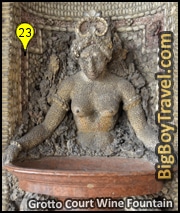
The oddest set of rooms in the Rezidenz are the lavish Stone Rooms which were built in 1612 and filled with tapestries solely to house the Holy Roman Emperor when he would visit. These unbelievable marble rooms were almost never used which is strange for how cool they are. They didn’t even put furniture or tapestries in the rooms unless the Emperor was there. At about the same time the rooms were built, parts of Neueveste Castle and Silver Tower started to be torn down to make way for the expanding Palace, which by 1701 surrounded 4 courtyards.
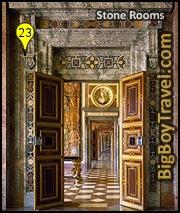
Like many of the rulers before him, Albrecht VII also had big ambitions for putting his own stamp on the Residenz in 1726. The first project was the building of new Ornate Rooms to keep up with the other Palaces in Europe. This new wing was filled with apartments stocked with over the top in rich furniture, artwork and designer wallpaper. It seems like almost every inch of these rooms is filled with paintings. Over the years a number the Ornate Rooms have housed many important guests such as Elizabeth II. Albrecht VII also got working on the Ancestral Gallery with portraits tracing back his famous bloodlines. Historians widely view the gallery as propaganda, but it worked as Albrecht VII persuaded the people he was related to Charlemagne and was elected Holy Roman Emperor. Hidden in many of the paintings today are huge square slash marks from where they were quickly cut from their frames to preserve them right before World War 2 bombings.
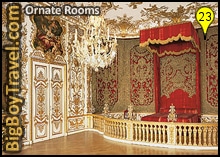
The most beautiful space in the entire Palace maybe the Residence Theater (Cuvilliés-Theater), constructed by Elector Maximilian Joseph III (1745-77) in 1753. Originally this theater was located between the Residenz and the State Opera House, but it was leveled in World War 2. Luckily just before the bombings most of the Theater’s impressive interior was removed and stored for safekeeping until after the war. When the dust had settled from the war the Theater was rebuilt with the original woodwork where a ballroom from the 1500s once stood. Below the Theater are a series of Gothic cellars from the ballroom that once connected to Nueveste Castle until the last parts of the Castle burned down in 1750. While these cellars are all that remain from the castle, an outline of its original footprint shape has been created on the pavement in the Northern courtyard.
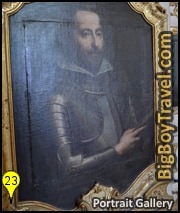
The last rounds of expansion happened in the after Bavaria officially became a Kingdom in 1806 under the rule of King Maximilian I Joseph. His son King Ludwig I (1825-1848) added a large Festival Hall Wing, the Kings Wing, and the unreal Court Church of All Saints. The Church was modeled after the Cappella Palatina in Palermo Sicily in a Byzantine-style and was filled with detailed golden mosaics. Unfortunately, the Church was heavily damaged in WW2 and none of the mosaics survived by the time it reopened as a concert venue in 2003. When King Ludwig II took over in 1864 he showed his flair for the dramatic by adding a huge greenhouse Winter Garden on the roof of the Northside of the Residenz. The Garden was meant to feel like a fairytale and had lighting for rainbow and moonlight effects. While it didn’t survive WW2, Ludwig’s masterpiece Neuschwanstein Castle two hours South of Munich is the most visited fairytale castle in Europe. After the revolution of 1918, the Wittlesbachs ended their 738-year rule and the Residenz immediately became a public museum.
Residence Hours: April-October 15th Daily 9am-6pm; October 16th-March Daily 10am-5pm (the Theater opens late Monday-Saturday at 2pm). Last entrance 1 hour before close. Entrance Cost: 7€ each for the Museum & Treasury or 11€ for both together, Theater is 3.5€, All 3 for 13€. All are covered by the Castle Pass. Orchestra Concerts: Every Thursday at 7pm and Saturday at both 6 and 7:30pm the Munich Philharmonic Orchestra has concerts in the same small wedding chapel Mozart played in for 21€. Hot Tips: If you plan on seeing other palaces and castles during your trip to Bavaria, we suggest getting the Bavarian Castles Pass which gets you into almost all Castles and Palaces for 14 days from your first use. This pass is 24€ for one person or 40€ for 2 adults plus your kids under 18 years old. Photos: (Residenz Layout Map | Antiquarium After WW2 | Neuveste in 1540 | Neuveste Cellars Today). 360 Degree Photos: (Antiquarium | Lion Statues | Portrait Gallery | Stone Rooms). Palace & Museum Website: (HERE).
24. Max Joseph Square:
About Max Joseph Platz: Even if you don’t have time for a show, the exterior of the Opera House looking down at the statue of ruler Max Joseph is still very impressive. Also consider grabbing a drink on the West side of the square at the outdoor tables to the Spatenhaus Beer Hall which has our favorite beer in Munich, Spaten.
Opera and the theater performances have both been big in Munich for 100s of years with opera companies operating here since the early 1600s. Maximilian I built the current Greek columned Opera House during his last year as King in 1825 after the original opera house burned down. The project was inspired by Pantheon in Rome and it covered with two impressive reliefs. The lower gable has a carved relief of Greeks gods flanking Apollo in the center. The upper gable is a beautiful golden mosaic with goddesses surrounding a bucking Pegasus. By the time it opened, the 2100 guest State Opera House was the largest in Europe. When Mad King Ludwig II took over in the 1860s he greatly expanded the Opera House’s offerings as he was obsessed with the work of Richard Wagner.
The Opera House was unfortunately turned to rubble during WW2 bombings, but it has since fully restored and today the building is grand as it ever was. Make sure to check out their website if you want to catch an opera or ballet. Opera House Guided Tours: 1 hour guided tours almost every day of the week at 2pm for 7€. The meeting point is on the Northern entrance toward Marstallplatz, and not Max Joseph Platz. Opera Website: (HERE).
25. Old Court Palace (Alter Hof):
About Alter Hof: The Old Royal Court (Alter Hof), was first built in the 1180s as a small royal estate for the Wittelsbach family who had just taken over the rule of Bavaria from Henry the Lion after he refused to fight for the Holy Roman Emperor. The family’s royal dynasty (1180-1918) over Bavaria would go on to last more than 700 years.
Between 1253-55, as Bavaria split into Upper & Lower states, Duke Ludwig II re-built and expanded Alter Hof turning it into the family’s formal Royal Court. This is also considered the point when the capital of Bavaria officially moved from Regensburg, Germany to Munich. In 1328 Ludwig IV, who was the 1st prince born in the new Alter Hof, became the King of Germany, the Romans, Italy and the Holy Roman Emperor. Ludwig IV’s rise power was also at the height of the regional salt trade and cemented the Wittelsbach’s as a major player in Europe.
As the Alter Hof grew, it was laid out with 5 wings around a central courtyard which housed farm-like gardens and Royal craftsmen. The palace grounds were home to many animals including pigs, chickens, horses, lions, and monkeys. One of the exhibits on display today has an interesting story about when a young prince Ludwig IV (mentioned above) was taken out of his crib as a baby and dangled high above a window by a pet monkey who eventually put him back unharmed. Today you will see monkeys painted on the outside of the turret windows inside Alter Hof’s central square called the Monkey Tower.
After a failed citizen’s uprising, the royal family built a small moated retreat called Neuveste Castle (now the Munich Residenz) for protection just North of Alter Hof in 1385. By 1474, the Wittelsbachs started to formerly split time between the two residences before official moving the Royal Court to Neuveste Castle in 1506 following the reunification of Upper & Lower Bavaria. After the move, Alter Hof was used to house government departments, a horse stable, and the royal mint while Neuveste was slowly expanded into today’s Munich Residenz Palace. You may remember the Munich Residenz from earlier in this free Munich walking tour.
While Alter Hof was heavily damaged in WW2, parts have been reconstructed to house exhibits where you can learn about its history and how day-to-day life was in a Medieval royal court. We find the Gothic Hall to be the most interesting of the exhibits today. Exhibit Cost: Free. Exhibit Hours: Monday-Saturday 10am-6pm. Museum Website: (HERE).
26. Baker’s Mill Restaurant (Pfistermühle):
About Pfistermühle: What an amazing vine-covered building with an interesting history! Before becoming a restaurant in 1988, the Pfistermühle was part of the Royal baker’s mill (Hofpfisterei) for the Bavarian dukes going back to the Middle Ages. There was once a stream powering the mill running right down the middle Sparkassenstraße Street (covered since the early 1990s) which also served as the original moat for Munich. The current building was added as a baking and a storage house for the mill and built in 1573.
The Baker’s Mill Restaurant has great food and you are served in one of the mill’s four original storage vaults. These happen to be the only original Medieval storage vaults still maintained in Munich. It’s even more astonishing that this part of the building survives today as the mill was heavily bombed in WW2 and half of the complex had to be completely rebuilt which now is home to the neighboring Platz Hotel. The hotel is one of our favorite hotels in Munich as you can’t get closer to the Medieval city center. With the combination of beauty, history, and great food it is easy to have fond memories of Pfistermühle Restaurant.
Hours: Open Monday-Saturday Noon-Midnight; Closed Sundays. Reservations: Reservations are suggested and can be made on their website. Photos: (Bakery In 1897 | Back of Bakery 1907 | Stream 1907) Restaurant Website: (HERE).
27. Royal Beer Hall (Hofbräuhaus):
About The Hofbräuhaus: The Hofbrauhaus, or Royal Court Brew House, is by far the most popular beer hall in Munich and maybe the most magical in the World! While beer has been brewed in Munich since 1328, Duke Wilhelm V established this official Royal Court Brewery in 1589 as an alternative to expensively shipping in his favorite beers in from Hanover, Germany (Saxony). The current 3-story beer hall complex opened in 1607 as an expansion to brew Hofbrau’s wheat beer and visiting it was reserved for the Royal family and their guests only. Mozart and Austrian Empress Sisi were some of the esteemed royal guests who would often visit.
In 1828, King Ludwig I opened the Hofbrauhaus beer hall to the public allowing both rich and poor to experience the World-famous atmosphere. Ludwig’s involvement was fitting as the King’s 5-day wedding celebration in 1810 was the start of the modern Oktoberfest and also helped to unite commoners and the social elite. The brewery has sponsored a 10,000 person beer tent during Oktoberfest since 1955, but the Hofbrauhaus Beer Hall has an excellent party atmosphere no matter what time of year you come.
Today, the Hofbrauhaus still brings people together with community seating, traditional barmaids, delicious German food, 1-liter glasses of golden Bavarian beer, smooth wine, and even live brass band oompah music. The food is not to be overlooked and is a highlight as much as the beer. Yes there are a lot of tourists at the Hofbrauhaus, but it’s still our favorite stop on this free Munich walking tour!
You will need to find a seat to get served at the Hofbrauhaus, but the community seating and friendly atmosphere make it easy to join other groups and make new friends. The only place you cannot sit is anywhere with a sign saying “Stammtisch”, which means it is reserved. Most of the 3,500 seats in spread throughout the beer hall’s rooms are open seating so don’t be afraid to join a table of strangers if there are spots available. The main floor is the most festive area and even has a lovely open-air beer garden with seating for 400 under the shade of chestnut trees near the beer pouring station. While on the way to the gift shop, check out the stein storage lockers called Masskrugtresor. There are a total of 424 mug lockers where local patrons store their custom steins between visits. The lockers, which cost 200 euros a year, are very prestigious and can now only be acquired through inheritance.
The upper floor of the Hofbrauhaus complex is often overlooked by tourists and holds a giant Festival Hall with a barrel ceiling. We LOVE the traditional Bavarian dance show held most evenings in the Festival Hall. Guests are enchanted by a musical program comprised of traditional Bavarian Schuhplattler dancers, alphorn players, yodelers, whip performers and cowbell players. It is in the 900 seat Festival Room that Hitler had some of his private meetings during the Nazi rise and occupation of Munich which were held at numerous beer halls. The most famous meeting in the Festival Hall was in 1920 where a speech Hitler gave which got him kicked out of the Bavarian army after unveiling his “25 Thesis”.
If you are feeling extra festive, wear your traditional lederhosen or dirndls to make friends even faster, just don’t wear tacky costume outfits from American Halloween shops, go in authentic gear. Also please don’t try to steal the beer steins. If you want a glass or stein to bring home, they do have a great gift shop where you can buy them.
Beer Hall Hours: Daily 9am-Midnight. Folk Buffet: On a lot of nights they have an all-you-can-eat Folk buffet upstairs for 20€ from 630-10pm. This buffet is heavy on music and folk dancing, but check out their website for a current event schedule. Drinking Tips: The 1-liter beer steins are called a ‘Mass,’ light beer is ‘helles,’ dark beer is ‘dunkel,’ and they also have a half beer/half lemon soda drink called ‘Radler’. Brewery Tours: You can also tour the official Hofbrau Brewery on the edge of town which is accessible in 40 minutes by the S2 Metro plus a short walk. (Address Hofbräuallee 1, More Info). Restaurant Website: (HERE).
Other Sights Near Old Town:
28. English Garden Walking Tour:
About The English Garden: Sitting as one of the world’s largest urban parks, the English Garden is the biggest in Europe and is even larger than New York’s Central Park. There can be over 100,000 people a day here in the summer, but because the park is so vast you would never notice. While you may be tempted to skip the park if cramped for time, it is too unique to skip, and serves and a great stop to rest and recharge your batteries. The highlights include World-Class river surfing, nude sunbathers, the Chinese Tower Beer Garden, and the Monopteros hilltop acropolis. Beer Garden Hours: Daily 9am-Late. 360 Degree Panorama: Click Here.
Read More: English Garden Walking Tour.
29. Beer & Oktoberfest Museum:
About The Beer & Oktoberfest Museum: Housed in Munich’s oldest home from 1340, this museum highlights the history of Munich’s Beer as well as the Oktoberfest celebration. Our favorite element of the amazing home is the 3 story tall the Stairway to Heaven. In medieval times it was common of stairs in a house to go up all the floors in a continuous unbroken line. As you check out the Beer Museum you follow how the making of beer was perfected in Munich including original recipes from the 1400s. The Oktoberfest Museum is a awesome step back into time showing how the marriage reception for King Ludwig I in 1810 has turned into the modern Oktoberfest. Today 600,000 people a day visit the 10 day long celebration with is a mix of state fair and beer halls. You wont find a better party in the World than you do in Oktoberfest’s mega tents which hold 4,000-10,000 people each.
Make your trip to the Beer & Oktoberfest Museum special is grabbing a bite to eat at in the basement Museumsstueberl Cellar Restaurant (website). The food can be a little strong on the sauerkraut, but it is about as traditional as you’ll find in Munich. The setting can also be a very romantic place to grab a drink as the tables and chairs in the cave-like, stone walled room are actually mad out of old, wooden beer and wine kegs. Museum Hours: Tuesday-Saturday 1-6pm. Museum Cost: 4€. Underground Restaurant Hours: Monday-Saturday 6pm-Midnight. Museum Website: (HERE).
30. Isartor City Wall Gate:
About The Isartor Gate: In 1175, the first fortified wall around Munich was completed, but the city quickly outgrew that footprint. The city of Munich was greatly expanded when a second wall was built further out from 1285 to 1337 which increased the footprint by 700%. The wall was a masterpiece, complete with a moat and eight gates, up from the original four. If you look on the map above you can see this expansion that turned the formerly oval shaped Old Town area into more of a kidney bean shape. This footprint is very important to see to help you feel more connect to the city as you follow our free Munich walking tour map.
Maybe the most important gate on the newly expanded wall was the mighty Isartor River Gate. It was nearby that in 1156 Henry the Lion built his Ludwigsbrücke tool bridge to reroute the Salt Road from Bad Reichenhall and Hallein on its way to Augsburg through Munich and established it as a town. The new Isartor Gate helped provide a curtain to protect the town as is one of only three gates still standing. In 1835, the central tower was rebuilt and frescoes depicting the victorious return of Louis IV in 1322 after the Battle of Mühldorf. Louis’ victory over the Austrian Habsburgs helped earn him the title of Holy Roman Emperor and strengthen Munich as a powerhouse in the Salt Trade through the 1300s. Today the gate is a popular spot for photographers and the attached cafe is a favorite of locals. Photos: (Isartor Gate in 1600s).
31. St. Luke’s Church (St. Lukaskirche): The large St. Luke’s Church is pretty bland inside, but is one of the few churches in Munich that actually has an prominent and powerful exterior. Because the large church sits right on the route for Tram Line 17, it is easy to admire it as you pass by if you don’t have time to explore it.
*Tram 19 takes you over the river and Prater Island directly to the…
32. Bavarian Parliament (Maximilianeum): Home of the Bavarian Parliament, Maximilianeum is a great example of renaissance architecture. While there isn’t a ton to see inside Maximilianeum, the atmosphere at neighboring Wienerplatz and it’s beer garden HofbrauKeller make it worth the trip. Wienerpatz is a cute square located just southeast of Maximilianeum which has a quaint old-world feel, complete with it’s own Maypole . A favorite backdrop for photos on the square fits the square, the May Pole, and the towering St Johns church all in one picture. If you’re starting to run short on time, feel free to bypass this stop all together by riding on Tram #17 all the way 17 to 19. 360 Degree Panorama: Click Here. Photos: (Wienerplatz).
*Tram 18 is the easiest way to get to the…
33. Deutsches Museum: Huge museum of arts and science spread out in a campus of buildings. It is Germany’s equivalent to the American Smithsonian in Washington DC. Great for kids and families. Restaurant Website: (HERE).
*Also sitting on the route for Tram 18 is one of Munich’s hidden gems, the…
34. Munich Puppet Theater (Münchner Marionettentheater): If you have never witnessed a classic Marionette production this is your chance. Skilled puppeteers carefully maneuver wooden characters, making them truly come to life with every string movement. The range of shows that are preformed in Munich is pretty big, but even if you aren’t familiar with the work the show will be amazing. Theater Website: (HERE).
35. Awesome Museums: A cluster of great museums often overlooked by tourists. Glyptohek Museum Built from 1813-1860. Is Munich’s oldest public museum; the only museum in the world that is solely dedicated to ancient sculpture. Pinakothek Art Museum is made up of a building for modern art and another for the classics.

